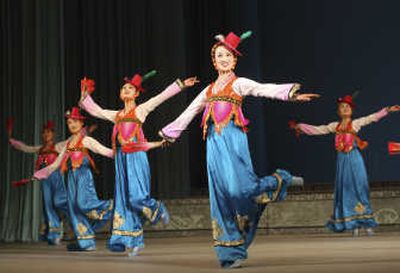Violin diplomacy in North Korea

PYONGYANG, North Korea – Swirling dancers and musicians beating traditional drums welcomed the New York Philharmonic to North Korea on Monday for a historic cultural exchange between countries that have been technically at war for more than a half-century.
In a burst of musical diplomacy notably devoid of propaganda glorifying leader Kim Jong Il or attacks on U.S. policy, North Korean dancers balanced water jars on their heads or twirled pink and green fans to entertain the celebrated American orchestra – which gave them a standing ovation.
The Philharmonic is the first major American cultural group to visit the isolated communist nation and the largest-ever delegation from the U.S. to visit its longtime foe.
As part of its 48-hour trip, the 106-member orchestra was to play a concert today that will be broadcast on state-run radio and TV, where the U.S. is the target of daily condemnation.
The orchestra held a full dress rehearsal today for its performance at the East Pyongyang Grand Theater set for later in the day, playing the U.S. and North Korean national anthems.
The concert’s program will feature Antonin Dvorak’s Symphony No. 9 in E Minor – popularly known as the “New World Symphony” and written while the 19th-century Czech composer lived in the United States – and George Gershwin’s “An American in Paris.”
Philharmonic music director Lorin Maazel said despite the trip’s political overtones, it was the right decision to go.
“It would have been a great mistake not to accept their invitation,” he said after arriving at the Pyongyang airport aboard a chartered 747 jet from Beijing. A border guard checked his passport upon exiting the plane before North Korean cultural officials greeted the orchestra with handshakes and smiles.
“I am a musician and not a politician. Music has always traditionally been an arena, an area where people make contact. It’s neutral, it’s entertainment, it’s person-to-person,” Maazel said.
He said if the music moves the audience, “we will have made whatever contribution we can make to bringing our peoples just one tiny step closer.”
But before the American orchestra was to take the stage, it was the North Koreans’ turn.
At the 500-seat Mansudae Art Theater, North Korean performers played traditional instruments such as the kayagum, a type of zither, and sang about their country’s natural beauty.
Like all parts of society under the authoritarian North Korean regime, the arts are viewed as a means to instill loyalty and bolster Kim’s personality cult.
Still, only the last number was overtly political: A woman dressed as a guerrilla and brandishing a red scarf performed a dance dramatizing Korean resistance to Japan’s colonial occupation before World War II, which according to North Korean official history was led by late founding ruler Kim Il Sung, father of current leader Kim Jong Il.
Dancers in flowing white robes swept across the stage, symbolizing the harsh winters suffered by the fighters. At the triumphal end of the performance, the backdrop picturing the Korean peninsula’s tallest peak, Mount Paektu, morphed into a stylized Pyongyang skyline where the windows of every building were filled with light.
Even the privileged residents of the North Korean capital suffer regular blackouts, but as the orchestra drove through the city, the streets were illuminated with neon propaganda slogans atop buildings and five-pointed stars dangling from streetlights. One billboard showed a fist crushing an American soldier. However, some anti-American posters were torn down before the U.S. musicians arrived, a diplomat based in the North Korean capital told orchestra members.
After the concert, Maazel presented the lead dancer with a bouquet and later praised the performers for their dedication.
“Through our music, through our art, we will be able to express our friendly feelings to North Korean artists and the North Korean people,” he said in a toast at a lavish banquet in the People’s Palace of Culture that featured roast salmon, crab au gratin and pheasant ball soup accompanied by an assortment of North Korean alcohol, from beer to ginseng liquor.
Michelle Kim, the South Korean-born assistant concertmaster of the Philharmonic, said the North Koreans’ performance featured traditional elements familiar to all Koreans.
“As I was listening to the concert, I didn’t think of it as North Korean or South Korean but just Koreans,” said Kim, a naturalized American citizen. “That’s our traditions, we’re the same people.”